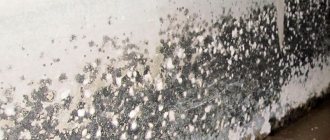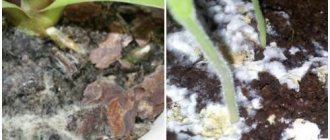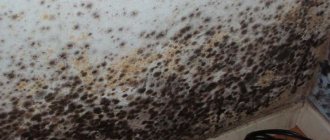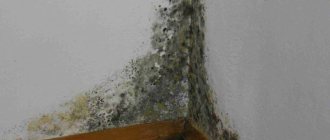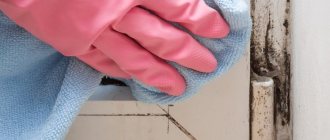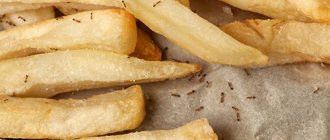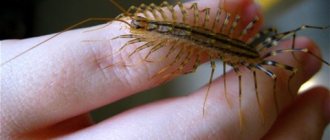The appearance of a black coating indicates that mold, dangerous to humans, has settled in the apartment or house. This fungus is difficult to remove on your own, so it is important to begin treatment when the first signs of infection appear. However, the destruction of microorganisms is not enough - it is worth taking preventive measures to prevent a re-attack of harmful spores.
General information
Mold appears on various surfaces and can grow very actively, destroying the room and rendering it unusable. Microorganisms pose a particular danger to the human body. Regardless of what you plan to do to remove mold, it is important to know the reasons for its appearance so that it does not reappear in the room.
Harm to humans
Black mold is a fungus that is extremely dangerous for adults and children. Toxic substances released by colonies of these microorganisms can cause:
- dermatitis, eczema, psoriasis;
- asthma, pneumonia, other diseases of the respiratory system;
- joint diseases;
- conjunctivitis;
- disorders of the kidneys and liver;
- dental problems (stomatitis, thrush);
- candidiasis on the genitals.
Scientists suggest that the more dangerous mold there is, the higher the likelihood of cancer. Spores penetrate the body, settle on internal organs and mucous membranes, and activate the process of decomposition of cells and tissues.
When the body is infected with mold, diagnosis is very difficult, since this type of mold is not always distinguishable. As a result, therapy is prescribed too late, and at best the disease develops into a chronic form, and at worst, irreversible consequences arise.
Viable mushrooms are very difficult to breed; they can survive in the cold and at high air temperatures. The death of microorganisms is observed only during boiling.
Black mold in the house is dangerous for humans and the longer its presence in the home, the higher the likelihood of the following symptoms occurring:
- active hair loss;
- memory impairment;
- numbness of the limbs;
- pain and other discomfort in the abdominal cavity;
- eye sensitivity to light;
- causeless increase in body weight;
- muscle cramps.
Reasons for appearance
The appearance and spread of black plaque is promoted by heat and moisture. In this case, the most optimal conditions are humidity up to 68% and air temperature up to 25 °C). If the room is rarely ventilated, fungus will definitely appear.
Other factors:
- Doors and windows with plastic profiles. If used incorrectly, they are a provoking factor. Plastic profiles prevent constant air movement due to their tightness. If the installation was carried out incorrectly, and the products themselves are of poor quality, condensation occurs. This creates suitable conditions for active growth and development of the fungus. The solution to the problem is a supply valve on the windows and regular ventilation of the premises.
- Drywall. The material is able to absorb moisture and retain it for a long time. In order to prevent black mold from developing, you need to follow all the rules for installing structures and leave enough time for them to dry completely. There are special types of drywall designed for high humidity conditions if installation is carried out in such a room. Antifungal compounds must be added to the solutions used.
- Insufficient ventilation. Most often, this problem occurs in the bathroom and toilet. The absence of windows, regular water procedures, and drying clothes contribute to a significant increase in air humidity, which an ordinary hood cannot cope with. Forced ventilation comes to the rescue.
- Damp walls and ceiling, damp environment in the basement. Sometimes errors at the design and construction stage lead to the fact that when precipitation falls, the corners of buildings get wet and then freeze in the winter season. The same thing happens if drainpipes are clogged or missing. In a damp basement, mold fungi can actively multiply and then penetrate through the ventilation system into living rooms and other rooms.
- Food. If store-bought bread was baked from moldy grain, it will very quickly become covered with a fungal coating. This product is dangerous to life. The piece should be packed in a plastic bag and thrown into a trash bin outside the home.
First signs
If black mold fungi have settled in the house, you can understand this by the following signs:
- dark spots, stains, persistent deposits on walls and other surfaces;
- darkening of the seams between tile panels in the bathroom, bathroom or kitchen;
- specific smell from air conditioning or heating devices;
- wallpaper coming away from the walls;
- persistent colds in residents, the appearance of symptoms of bronchial asthma, allergies, itching;
- musty indoor air;
- an unreasonable feeling of fatigue and loss of strength;
- cases of flooding in the bathroom or toilet.
Types of black mold
A black mold coating, which is visible to the naked eye, is an external manifestation of fungal colonies. Such microorganisms can be of different types, but the most common types found in residential areas are:
- Aspergillus black. It actively reproduces and exists in a humid environment, which is present in the bathroom, toilet, swimming pool, kitchen. This type of mold can often be seen in washing machines, air conditioners, and home humidifiers. Even with the slightest fluctuation in the wind, spores are spread throughout the room, penetrate the respiratory tract of humans and animals, and settle on clothing and food. Mold causes serious pathological processes in the human body, including death.
- Aspergillus fume. This type of fungus is resistant to high temperatures (up to 55°C). The spores easily enter the human body due to their very small size. People with weakened immune systems are most susceptible to infection. Most often, such mold is found on vegetables and fruits with mechanical damage. Toxins released by fungi cause allergies and destroy red blood cells (erythrocytes) in biological material, preventing the strengthening of the immune system.
- Alternaria alternata. Most often, such a fungus can be found on dying autumn leaves, spoiled vegetables and fruits. Microorganisms easily take root on food, clothing and other textiles. The fungus loves moisture, but the spores spread in dry, windy weather under the sun's rays. Wooden houses are susceptible to the penetration of such mold to a greater extent than concrete buildings.
Symptoms of diseases of the human body
How much mold affects human health and how quickly the first symptoms appear largely depends on the type of fungus, the degree of infection of the room, the general condition and individual characteristics of a particular organism. At first, living or regularly staying in an infected room may result in the following symptoms:
- runny nose;
- headache;
- lacrimation;
- skin irritation;
- sore throat;
- dry cough;
- weakness;
- nosebleeds;
- fast fatiguability.
Fast fatiguability
If you do not take measures to cleanse your home of mold, the consequences will not be long in coming. So what diseases do molds cause?
This:
- dermatoses, mycoses, dermatitis;
- bronchial asthma, bronchitis, pneumonia, tuberculosis;
- migraine;
- rhinitis;
- conjunctivitis;
- intoxication (nausea, vomiting, indigestion);
- joint diseases;
- kidney and liver diseases.
Constant contact with mold reduces immunity, so frequent colds, exacerbations and complications of chronic diseases are possible.
How to get rid of black mold
The more dangerous mold there is in your home, the more difficult it is to get rid of it. If the affected area is small, and the fungus has just begun to spread throughout the room, you can try to destroy it with improvised means or chemical compounds. If there is no positive result, only professional removal will help.
Safety precautions
In order to prevent black mold from causing harm to health and other negative consequences, as well as for greater processing efficiency, you must adhere to the following rules:
- during manipulations to remove microorganisms, wear a respirator, gloves and safety glasses;
- cover the surface not covered with plaque with polyethylene to prevent its migration from damaged objects;
- the maximum amount of clean items should be temporarily removed from the area being treated;
- if mold has covered a large area, objects not affected by fungi must be securely wrapped in film;
- to prevent mold spores from spreading throughout the room or other premises, it is forbidden to open a window or turn on a fan;
- in no case should you remove plaque from surfaces with a vacuum cleaner, since in this case the spores will remain inside the electrical appliance and will wait for the right moment and conditions for active reproduction;
- It is recommended to dry the air in the room using a special device - mushrooms do not live in such an environment;
- After carrying out manipulations to clean surfaces from microorganisms, you need to throw away all used rags, film, protective gloves, masks and other devices on which spores could remain.
Folk remedies
You can fight against dangerous plaque with improvised means, which are found in almost every home:
- Hydrogen peroxide. All areas affected by the fungus should be treated with the substance. The bleaching effect makes the use of this product impossible on colored surfaces.
- Soda and vinegar. For 5 liters of water you need to take 200 g of soda and 100 g of table vinegar. It is necessary to carefully treat the fungus with the resulting solution. Most often used for preventive purposes, rather than for disinfection of large areas of damage.
- Ammonia. To work with this toxic product, you need to use a respirator and other protective equipment. Having previously moistened the mold surface, it is worth treating it with ammonia, waiting about half an hour and thoroughly rinsing off the substance. When carrying out manipulations, the room must be closed, and at the end of the procedure it is important to ventilate it for 2-3 hours.
- Tea tree oil. The substance is diluted in water in a ratio of 1:50 and applied to the fungus. After 3–4 hours, the room should be ventilated.
In most cases, folk remedies are not able to get rid of mold completely. With their help, you can remove only visible manifestations of plaque. Spores that have grown into wood and other materials can only be removed using professional methods.
We recommend:
How to remove shine from iron on clothes
Chemical and special products
If home remedies are ineffective, chemical compounds will help:
- Copper sulfate. For 1 part powder, take 10 parts water and mix the ingredients. The mixture is applied to the moldy areas with a brush, after which a time interval of several hours is maintained. After the specified time, the substance must be washed off. It is important to keep children and pets away from the premises, otherwise this could result in serious poisoning.
- Borax. The substance is diluted in a separate glass, then added to 10 liters of water. Damaged areas are treated and then left for 10 minutes.
- Chlorine bleaches. The product not only helps to remove fungi, but is also used for preventive purposes to disinfect the premises. It is enough to wipe the moldy seams on the tiles with the composition, and the plaque will disappear. The product must be washed off.
In household chemical stores you can purchase professional antifungal compounds:
- METAS-BIO solution;
- water antiseptic NANO-FIX;
- SCHIMMELENTFERNER fungus removal solution;
- OLIMP;
- Abedis 06 with chlorine;
- Fongifluid Alpa;
- Dali antiseptic.
Professional equipment
Black mold fungi are afraid of dry air and high temperatures, so microwave drying is one of the best methods by which you can destroy plaque and spores - black mold in an apartment is dangerous because it penetrates very deeply and is rarely removed with household products. Advantages of microwave:
- treatment of any surfaces in different rooms;
- safety for humans and pets;
- does not require preparatory actions;
- the ability to remove fungus through other surfaces;
- small time costs even with large areas of damage.
Laser beams penetrate deep into the material (up to 35 cm), heat it to 70 °C and kill spores and mycelium. This way you can get rid of black mold forever.
The dangers of mold and mildew
Firstly, such a neighborhood has an adverse effect on the health of residents, becoming a catalyst for diseases such as:
- asthma,
- pneumonia,
- sinusitis,
- skin rashes,
- migraine,
- stomach upsets,
- nosebleeds,
- various respiratory tract lesions.
But, secondly, it destroys the house, and does it from the inside. External manifestations of mold are just the tip of the iceberg, as they say, and even after getting rid of the stains, you can expect them to return after a while. Which suggests that first of all it is worth fighting not the effect, but the cause, that is, eliminating the favorable conditions created for the development of the fungus.
Prevention after treatment
Dealing with harmful mold of any kind is a long process that requires a lot of labor. It is much easier to take measures to prevent the appearance of plaque on surfaces in the house:
- regularly ventilate all rooms, especially the bathroom and toilet;
- clean your home thoroughly and periodically disinfect it;
- monitor humidity, take an interest in this indicator in neighboring apartments, common basements;
- prevent the formation of condensation on windows, walls and doors;
- waterproof the basement if it is very wet;
- treat the surfaces with special antifungal agents;
- insulate the room when it freezes in the cold season.
When you need specialist help
In most cases, the use of folk recipes and household chemicals does not bring results. Only the visible part of the plaque is removed, the mycelium remains deep inside, so after some time, colonies of the fungus reappear in the room. Mold can be removed forever only with the help of specialists. Stages of fungus removal by professionals:
- assessment of area and degree of penetration;
- evacuation of fabric products and other undamaged items from the premises;
- destruction of all visible areas with fungus, including plaster;
- Microwave processing;
- application of fungicides;
- disinfection.
It is very difficult to defeat black mold, but it is possible. It is important to provide indoor conditions that prevent the appearance and proliferation of fungus. If mold does appear, it is necessary to remove it as quickly as possible using professional or improvised means.
5/5 — (1 vote)
Where to go if mold appears in the apartment?
We tried to deal with the mold ourselves, but of course there are authorities that can help you. If you live in a municipal apartment, then the management company should deal with this issue. Only in practice it turns out that you can wait years for help from her.
Of course, housing office employees will try to absolve themselves of this responsibility and prove that the fungus arose through the fault of the residents. They may even appoint a commission or go to court, and you will also have to pay costs. Save your energy, time and nerves, because most likely you will have to fight alone.
It’s better to spend money on contacting a cleaning company, there will be people there ready to help. There are many such companies in the modern service market, of course, if you live in an urban area, in villages this is more difficult.
I hope my experience and advice will be useful to you. I never tire of repeating that mold is a creature that devours everything living and inanimate. It harms our body, and the fungus is especially dangerous for the health of our children, for their still unformed immunity, which is so vulnerable.
Don't let things go to chance, don't waste time. If the problem of black mold is just beginning to bother you, you need to immediately take active action.

